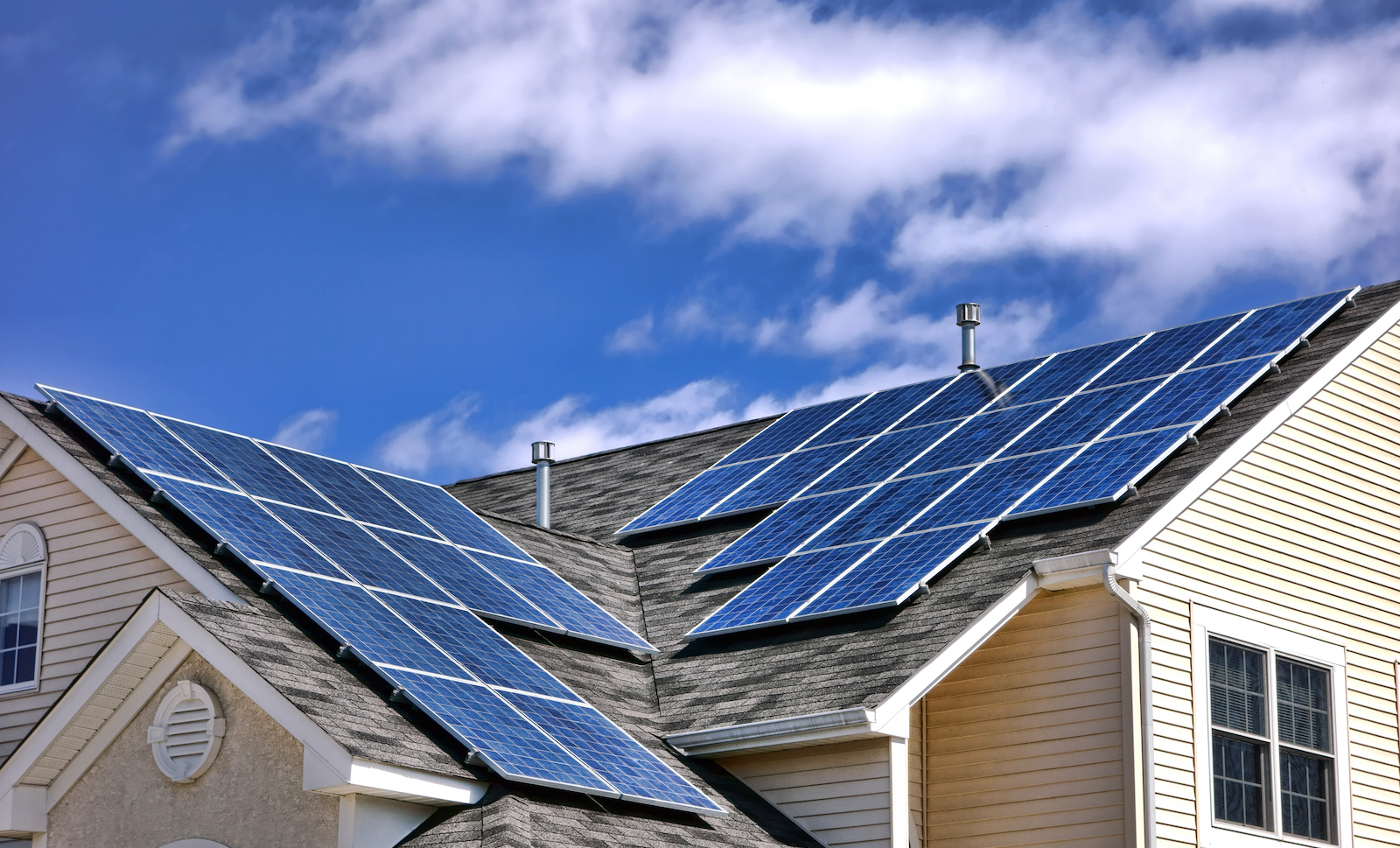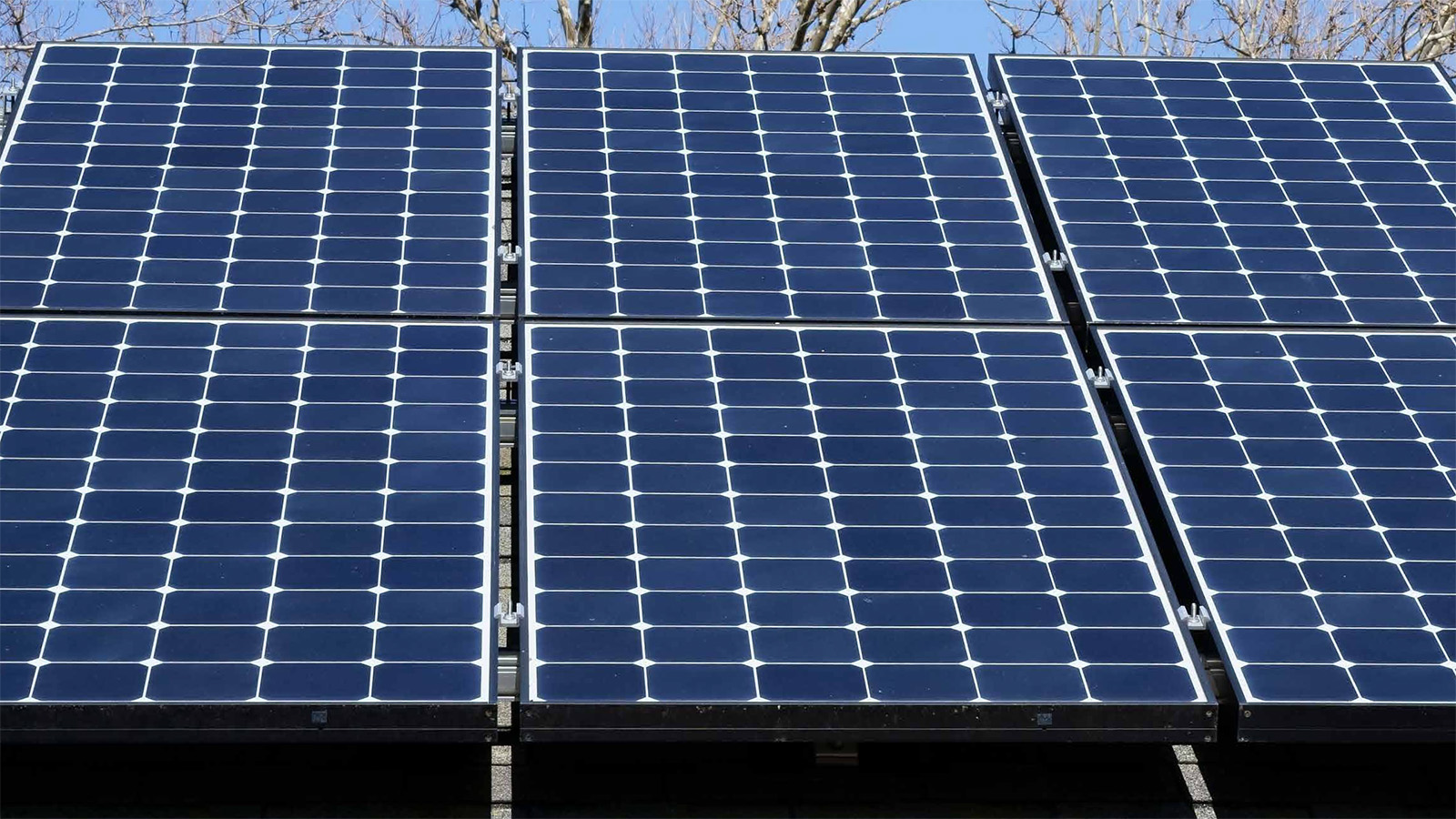
Solar Homes
The Next Step for Clean Energy
America has a bold opportunity to speed the transition to a clean energy future by requiring solar power on new homes. Rooftop solar panels save homeowners money – even more so when they are installed during construction. Including this common-sense technology on all new homes would help the nation to build an electric grid that’s cleaner, more beneficial for consumers, and more resilient.
Installing solar panels on all new homes would accelerate the growth of solar energy capacity. Installing solar panels on all new homes built from 2020 to 2026 would result in more solar energy capacity than the entire U.S. currently has installed. By 2045, installations on new homes would total 203 GW - 3.5 times as much solar capacity as the U.S. currently has installed. (Details on sources and methods for estimates can be found in the Methodology).
Executive Summary
America has a bold opportunity to speed the transition to a clean energy future by requiring solar power on new homes. Rooftop solar panels save homeowners money – even more so when they are installed during construction. Including this common-sense technology on all new homes would help the nation to build an electric grid that’s cleaner, more beneficial for consumers, and more resilient.
Installing solar panels on all new homes would accelerate the growth of solar energy capacity. Installing solar panels on all new homes built from 2020 to 2026 would result in more solar energy capacity than the entire U.S. currently has installed. By 2045, installations on new homes would total 203 GW - 3.5 times as much solar capacity as the U.S. currently has installed. (Details on sources and methods for estimates can be found in the Methodology).
Figure ES-1: Projected Cumulative Residential Solar Photovoltaic (PV) Capacity Added in U.S. under a Solar Homes Requirement.*
* See Methodology for sources and details on how projections were calculated.
Adding solar energy to new homes would offset the use of fossil fuel-powered energy sources and cut 2017 carbon dioxide emissions from U.S. electricity generation by more than 9 percent annually by 2045. A solar homes requirement would cut an estimated 161 million metric tons of CO2 equivalent during 2045 – equivalent to taking more than 34 million of today’s cars off of the road.
Figure ES-2: Projected Annual Greenhouse Gas Emissions Averted under a Solar Homes Requirement.*
* See Methodology for sources and details on how projections were calculated.
A solar homes requirement would add the most capacity in the fastest growing states and help to reduce increasing demand on the electric grid in those states. Texas would add the most capacity to new homes with over 24 GW by 2045, followed by Florida, North Carolina, Georgia and Arizona.
A solar homes requirement would also significantly reduce states’ carbon dioxide emissions. North Carolina, for example, could reduce annual CO2 emissions from energy use by the equivalent of 9 percent of 2015 levels by 2045. By 2045, Nevada and Arizona could reduce annual CO2 emissions from energy use by 8 percent of 2015 levels; Florida, South Carolina and Colorado by 7 percent; and Utah, Idaho and Georgia by 6 percent.
Table ES-1: The Top 10 States for New Residential Solar PV Capacity under a Solar Homes Requirement.*
State
Q2 2018 Total Solar PV Capacity (MW)
Projected Added Residential Solar PV Capacity by 2045 under a Solar Homes Requirement (MW)
% Reduction in 2015 CO2 Emissions by 2045**
Texas
2,624
24,719
3.2%
Florida
1,943
24,423
7.3%
North Carolina
4,491
13,160
9.0%
Georgia
1,556
9,665
6.0%
Arizona
3,613
7,601
8.1%
South Carolina
591
6,113
7.2%
Washington
133
5,959
4.9%
Colorado
1,055
5,904
6.9%
Tennessee
238
5,396
5.2%
California
22,777
5,200
0.8%
* See Appendix for full list of states. See Methodology for sources and details on how projections were calculated.
** Excludes net emissions from agriculture, land use and forestry.
Requiring solar panels on new homes could transform the market and lower solar energy costs.
Requiring solar panels on all new homes could lead to technological developments, market maturation and increased partnerships between home builders and solar companies. A 2018 NREL study found that these advancements could collectively reduce the price of solar systems by 59 percent.
Installing solar panels during construction is a key part of a transition to low-carbon and zero-carbon homes. A solar homes requirement meshes well with key energy policies such as strong building and appliance efficiency standards, electric vehicle policies, and policies to encourage home energy storage – helping to create a clean energy system.
Energy efficient design and appliances: Increasing the energy efficiency of homes and appliances can significantly reduce electricity consumption – allowing solar power to meet a greater percentage of homes’ energy needs.
Electric homes and vehicles: If homes adopt electric heating, hot water systems and vehicles, on-site solar panels can power them at least in part with clean, renewable energy.
Battery storage: Home battery systems can store excess solar power for use later when solar energy production is low. This saves homeowners money and also helps reduce both demand on and discharges to the grid, helping the grid operate more smoothly.
Distributed solar energy reduces air pollution, improves public health, and makes the electric grid more resilient.
Switching to solar energy reduces air pollution, improving public health. By offsetting the burning of coal and gas for electricity, solar panels improve air quality in our communities. From 2007 to 2015, wind and solar energy were estimated to prevent 3,000 to 12,700 premature deaths in the U.S. by improving air quality.
Distributed solar energy makes the electric grid more resilient. Distributed solar energy, when coupled with energy storage, can keep the power on during outages. This helps minimize impacts for those affected by disasters.
Starting in 2020, the state of California will require new single-family homes, and multi-family homes up to three stories, to install solar photovoltaic (PV) systems. Homes that cannot effectively accommodate solar panels due to shading from adjacent structures, such as buildings and trees, are exempt from the requirement.
This requirement is part of the California Energy Commission’s 2019 Building Energy Efficiency Standards, which also ramp up energy efficiency requirements for buildings. The new standards are expected to reduce greenhouse gas emissions from 2020 to 2023 equivalent to taking 115,000 cars off the road. Under the new standards homeowners are expected to save $19,000 over 30 years.
To take advantage of these benefits, state and local governments across the country should require all new homes to install solar PV systems. To support this policy and maximize its benefits, governments should also:
Set strong energy efficiency standards for homes. Improving energy efficiency in homes is one of the most important steps to make a renewable energy system work. The average single-family home in the U.S. would need over 9 kW of solar panels to meet its electricity usage versus the average home solar system size installed during 2017 of 7.4 kW. By eliminating energy waste through high-efficiency lighting and electric appliances, and by improving the energy-efficiency of attics, walls, windows and doors, rooftop solar panels can better meet homes’ energy needs.
Accelerate home electrification and adoption of electric vehicles. Transitioning home heating and hot water systems, and other appliances that currently run on gas and oil, to solar hot water or electricity can maximize the benefits of residential solar energy. The same is true of switching from gasoline-powered to electric vehicles, which are often recharged at home. All-electric homes can meet much or all of their energy needs with rooftop solar panels – benefiting homeowners financially and helping to transition to a 100 percent clean, renewable energy system.
Support energy storage. Residential batteries allow homeowners to store excess solar energy, powering homes when solar energy production is low and during peak electricity demand times. This saves homeowners money, which can make solar energy attractive even in a state that doesn’t have pro-solar policies like net metering in place. Reducing demand during peak demand times can reduce electricity costs for all utility customers and reduce the need for “peaker” power generators that only operate during these times and tend to be the costliest and most polluting.
Appendix
States’ current solar PV capacities, and projected residential solar PV capacities and reductions in CO2 emissions by 2045 under a solar homes requirement. See Methodology for sources and details on how projections were calculated.
State
Q2 2018 Total Solar PV Capacity (MW)
Projected Added Residential Solar Energy Capacity by 2045 under a Solar Homes Requirement (MW)
% Reduction in Energy Sector CO2 Emissions by 2045*
Alabama
251
2,558
1.5%
Alaska
2
248
N/A
Arizona
3,613
7,601
8.1%
Arkansas
141
1,339
1.8%
California
22,777
5,200
0.8%
Colorado
1,055
5,904
6.9%
Connecticut
498
776
1.1%
Delaware
121
898
3.6%
District of Columbia
53
174
3.0%
Florida
1,943
24,423
7.3%
Georgia
1,556
9,665
6.0%
Hawaii
849
625
N/A
Idaho
414
2,402
6.1%
Illinois
98
3,558
1.6%
Indiana
317
3,706
2.0%
Iowa
71
1,817
2.3%
Kansas
16
1,597
3.2%
Kentucky
41
2,213
1.7%
Louisiana
92
2,994
0.9%
Maine
42
598
1.2%
Maryland
967
2,577
4.3%
Massachusetts
2,226
2,356
1.9%
Michigan
118
4,187
2.3%
Minnesota
901
3,683
3.0%
Mississippi
228
1,444
1.3%
Missouri
168
2,736
2.3%
Montana
54
554
2.0%
Nebraska
21
1,338
3.1%
Nevada
2,658
4,111
8.4%
New Hampshire
76
647
2.0%
New Jersey
2,526
2,516
1.2%
New Mexico
753
1,179
2.9%
New York
1,463
3,555
1.2%
North Carolina
4,491
13,160
9.0%
North Dakota
0
437
0.8%
Ohio
182
4,633
2.1%
Oklahoma
48
2,076
1.9%
Oregon
477
2,797
3.9%
Pennsylvania
386
4,847
1.7%
Rhode Island
65
255
1.0%
South Carolina
591
6,113
7.2%
South Dakota
1
736
4.4%
Tennessee
238
5,396
5.2%
Texas
2,624
24,719
3.2%
Utah
1,627
4,094
6.4%
Vermont
227
285
0.9%
Virginia
635
4,996
3.0%
Washington
133
5,959
4.9%
West Virginia
7
545
0.6%
Wisconsin
56
3,030
2.7%
Wyoming
2
351
0.8%
* Excludes net-emissions from agriculture, land use and forestry.
Downloads
Environment Georgia Research & Policy Center

Executive Summary
America has a bold opportunity to speed the transition to a clean energy future by requiring solar power on new homes. Rooftop solar panels save homeowners money – even more so when they are installed during construction. Including this common-sense technology on all new homes would help the nation to build an electric grid that’s cleaner, more beneficial for consumers, and more resilient.
Installing solar panels on all new homes would accelerate the growth of solar energy capacity. Installing solar panels on all new homes built from 2020 to 2026 would result in more solar energy capacity than the entire U.S. currently has installed. By 2045, installations on new homes would total 203 GW – 3.5 times as much solar capacity as the U.S. currently has installed. (Details on sources and methods for estimates can be found in the Methodology).
Adding solar energy to new homes would offset the use of fossil fuel-powered energy sources and cut 2017 carbon dioxide emissions from U.S. electricity generation by more than 9 percent annually by 2045. A solar homes requirement would cut an estimated 161 million metric tons of CO2 equivalent during 2045 – equivalent to taking more than 34 million of today’s cars off of the road.
A solar homes requirement would add the most capacity in the fastest growing states and help to reduce increasing demand on the electric grid in those states. Texas would add the most capacity to new homes with over 24 GW by 2045, followed by Florida, North Carolina, Georgia and Arizona.
A solar homes requirement would also significantly reduce states’ carbon dioxide emissions. North Carolina, for example, could reduce annual CO2 emissions from energy use by the equivalent of 9 percent of 2015 levels by 2045. By 2045, Nevada and Arizona could reduce annual CO2 emissions from energy use by 8 percent of 2015 levels; Florida, South Carolina and Colorado by 7 percent; and Utah, Idaho and Georgia by 6 percent.
Requiring solar panels on new homes could transform the market and lower solar energy costs.
-
Requiring solar panels on all new homes could lead to technological developments, market maturation and increased partnerships between home builders and solar companies. A 2018 NREL study found that these advancements could collectively reduce the price of solar systems by 59 percent.
Installing solar panels during construction is a key part of a transition to low-carbon and zero-carbon homes. A solar homes requirement meshes well with key energy policies such as strong building and appliance efficiency standards, electric vehicle policies, and policies to encourage home energy storage – helping to create a clean energy system.
-
Energy efficient design and appliances: Increasing the energy efficiency of homes and appliances can significantly reduce electricity consumption – allowing solar power to meet a greater percentage of homes’ energy needs.
-
Electric homes and vehicles: If homes adopt electric heating, hot water systems and vehicles, on-site solar panels can power them at least in part with clean, renewable energy.
-
Battery storage: Home battery systems can store excess solar power for use later when solar energy production is low. This saves homeowners money and also helps reduce both demand on and discharges to the grid, helping the grid operate more smoothly.
Distributed solar energy reduces air pollution, improves public health, and makes the electric grid more resilient.
-
Switching to solar energy reduces air pollution, improving public health. By offsetting the burning of coal and gas for electricity, solar panels improve air quality in our communities. From 2007 to 2015, wind and solar energy were estimated to prevent 3,000 to 12,700 premature deaths in the U.S. by improving air quality.
-
Distributed solar energy makes the electric grid more resilient. Distributed solar energy, when coupled with energy storage, can keep the power on during outages. This helps minimize impacts for those affected by disasters.
Starting in 2020, the state of California will require new single-family homes, and multi-family homes up to three stories, to install solar photovoltaic (PV) systems. Homes that cannot effectively accommodate solar panels due to shading from adjacent structures, such as buildings and trees, are exempt from the requirement.
This requirement is part of the California Energy Commission’s 2019 Building Energy Efficiency Standards, which also ramp up energy efficiency requirements for buildings. The new standards are expected to reduce greenhouse gas emissions from 2020 to 2023 equivalent to taking 115,000 cars off the road. Under the new standards homeowners are expected to save $19,000 over 30 years.
To take advantage of these benefits, state and local governments across the country should require all new homes to install solar PV systems. To support this policy and maximize its benefits, governments should also:
-
Set strong energy efficiency standards for homes. Improving energy efficiency in homes is one of the most important steps to make a renewable energy system work. The average single-family home in the U.S. would need over 9 kW of solar panels to meet its electricity usage versus the average home solar system size installed during 2017 of 7.4 kW. By eliminating energy waste through high-efficiency lighting and electric appliances, and by improving the energy-efficiency of attics, walls, windows and doors, rooftop solar panels can better meet homes’ energy needs.
-
Accelerate home electrification and adoption of electric vehicles. Transitioning home heating and hot water systems, and other appliances that currently run on gas and oil, to solar hot water or electricity can maximize the benefits of residential solar energy. The same is true of switching from gasoline-powered to electric vehicles, which are often recharged at home. All-electric homes can meet much or all of their energy needs with rooftop solar panels – benefiting homeowners financially and helping to transition to a 100 percent clean, renewable energy system.
-
Support energy storage. Residential batteries allow homeowners to store excess solar energy, powering homes when solar energy production is low and during peak electricity demand times. This saves homeowners money, which can make solar energy attractive even in a state that doesn’t have pro-solar policies like net metering in place. Reducing demand during peak demand times can reduce electricity costs for all utility customers and reduce the need for “peaker” power generators that only operate during these times and tend to be the costliest and most polluting.
Topics
Find Out More


Recording of Rooftop Solar on the Rise webinar

Rooftop solar on the rise


